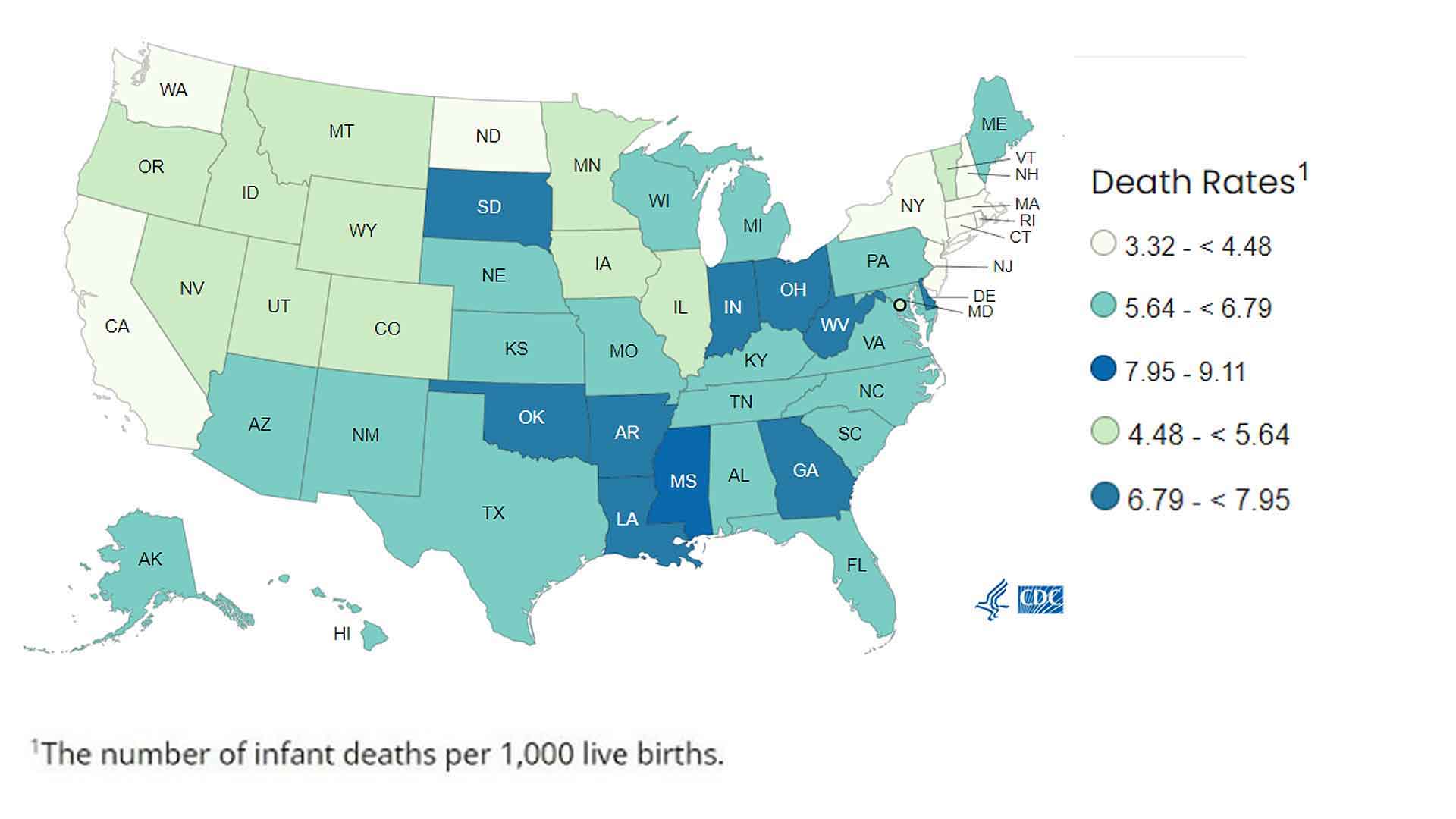
Infant Mortality Report
Sustainable Development Goals
The Sustainable Development Goals (SDGs) are a set of global goals adopted by the United Nations in 2015. They aim to address various social, economic, and environmental challenges and promote sustainable development worldwide. One of the SDGs is to ensure healthy lives and promote well-being for all at all ages, which includes reducing infant mortality rates.
Infant Mortality Rates by State, 2022
Infant mortality is the death of an infant before his or her first birthday. The infant mortality rate is an important marker of the overall health of a society. In 2022, the infant mortality rate in the United States was 5.6 deaths per 1,000 live births.
Geographically, infant mortality rates in 2022 were highest among states in the South and in the Midwest. In 2022, 19 states met the Healthy People 2030 target, which aims to reduce the rate of all infant deaths. Additionally, 15 states met the Healthy People 2030 target of 5.0 infant deaths or less per 1,000 live births.
For more information, you can view the Infant Mortality Rates by State Map from the National Center for Health Statistics.

Infant Mortality Rates by Race and Ethnicity, 2022
In 2022, the infant mortality rates (per 1,000 live births) by race and ethnicity were as follows:
- Non-Hispanic Black: 10.9
- Non-Hispanic American Indian and Alaska Native: 9.1
- Non-Hispanic Native Hawaiian or other Pacific Islander: 8.5
- Hispanic: 4.9
- Non-Hispanic white: 4.5
- Non-Hispanic Asian: 3.5
For brevity, the text does not include the term “single-race.” All records that indicated Hispanic ethnicity are classified as Hispanic regardless of race.
CDC Activities
The Centers for Disease Control and Prevention (CDC) is committed to improving infant outcomes. CDC and other public health agencies work with health care providers, communities, and other partners to reduce infant mortality. This joint approach can help address social, behavioral, and health risk factors that contribute to infant mortality.
Perinatal Quality Collaboratives (PQCs)
CDC provides support to 36 Perinatal Quality Collaboratives (PQCs). PQCs are state or multistate networks of multidisciplinary teams working to improve the quality of care for mothers and babies.
Maternal and Child Health Epidemiology Program (MCHEP)
The Maternal and Child Health Epidemiology Program (MCHEP) assigns epidemiologists and fellows to states, localities, and tribes. These assignees support epidemiologic research and provide scientific information to improve maternal and child health programs and policies.
CDC Levels of Care Assessment Tool (CDC LOCATe)
CDC provides technical support to states to implement the CDC Levels of Care Assessment Tool (CDC LOCATe). This helps states to map and strengthen systems of risk-appropriate care to make sure moms and babies get the right care, in the right place, at the right time.
Grief Resources
SDGs, Targets, and Indicators Analysis
1. Which SDGs are addressed or connected to the issues highlighted in the article?
- SDG 3: Good Health and Well-being
The article discusses infant mortality rates, which is an important indicator of the overall health of a society. This aligns with SDG 3, which aims to ensure healthy lives and promote well-being for all at all ages.
2. What specific targets under those SDGs can be identified based on the article’s content?
- Target 3.2: By 2030, end preventable deaths of newborns and children under 5 years of age, with all countries aiming to reduce neonatal mortality to at least as low as 12 per 1,000 live births and under-5 mortality to at least as low as 25 per 1,000 live births.
The article mentions the infant mortality rate in the United States, which is a measure of deaths of infants before their first birthday. Target 3.2 specifically focuses on reducing neonatal mortality and under-5 mortality, which are relevant to the issue discussed in the article.
3. Are there any indicators mentioned or implied in the article that can be used to measure progress towards the identified targets?
- Infant mortality rate: The article states that the infant mortality rate in the United States was 5.6 deaths per 1,000 live births in 2022. This indicator can be used to measure progress towards reducing neonatal mortality and under-5 mortality.
The infant mortality rate mentioned in the article serves as an indicator to measure progress towards the target of reducing preventable deaths of newborns and children under 5 years of age.
SDGs, Targets, and Indicators Table
| SDGs | Targets | Indicators |
|---|---|---|
| SDG 3: Good Health and Well-being | Target 3.2: By 2030, end preventable deaths of newborns and children under 5 years of age, with all countries aiming to reduce neonatal mortality to at least as low as 12 per 1,000 live births and under-5 mortality to at least as low as 25 per 1,000 live births. | Infant mortality rate: The article mentions that the infant mortality rate in the United States was 5.6 deaths per 1,000 live births in 2022. |
Source: cdc.gov







